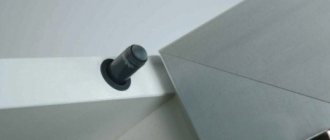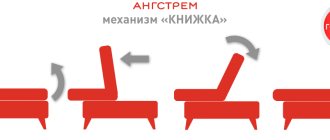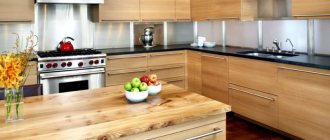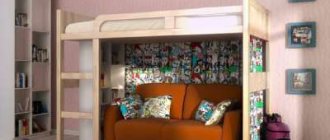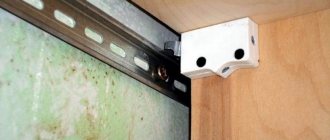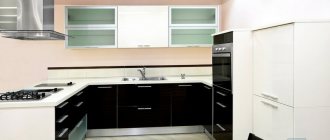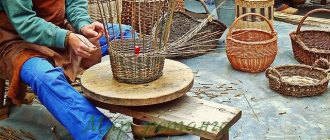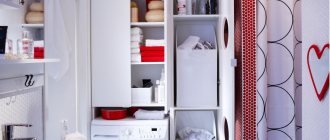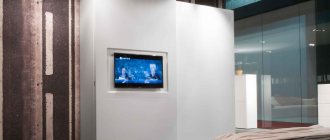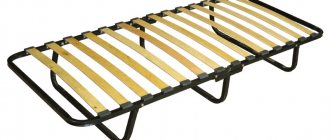Moldings for kitchen facades are a type of available decorative elements that are used for cladding furniture. This type of finishing allows you to update the interior and achieve the intended style. To purchase such decor for your furniture, just visit our online store, which will offer you the following:
- Wide selection of products for designing surfaces of structures;
- High quality of the goods displayed in the catalogue;
- Prompt and professional service;
- Affordable prices for products that are affordable to every customer.
Only part of the assortment is presented; the full catalog is available from the measurer.
Popular publications
latest comments
It's time to freshen up the situation in the kitchen, but buying new kitchen furniture is not yet included in the family budget? How to update your kitchen set at minimal cost?
In such cases, professional designers and decorators advise replacing the old countertops and facades with new ones, repainting the “familiar” facades in a different color or covering them with self-adhesive film, and also updating the fittings.
How to update your kitchen set at minimal cost?
What are moldings in the interior - furniture decor ideas
A modern decorative element that is used to decorate the interior of a room, external facade, car body and even pieces of furniture is called molding.
All kinds of profile strips, baseboards, cornices, platbands and curly overlays are made from natural and polymer materials.
Metal, wood or polyurethane molding allows you to update the outdated design of cabinet furniture. It is used to replace upholstery on sofas and armchairs, and decorate the backs of chairs and beds. Lightweight overhead elements can be installed with your own hands.
Types of moldings for decorating furniture
Chest of drawers decorated with polyurethane molding
You can completely change the interior of a room with the help of a new furniture set. A wide selection of furniture moldings for various purposes and configurations allows you to avoid large expenses and update the decor in accordance with the style of the room.
You can come up with an original decor design yourself or use ready-made samples. Taking into account the condition of the surface that needs to be transformed, molding of a certain shape and texture is selected.
Functionality of furniture molding:
- Decorating the facades of new furniture.
- Updating old headsets.
- Masking defects: cracks, scratches, chips, stains.
- Protection against damage to corners and smooth surfaces.
- Framing of inserts made of finishing material.
- Fastening upholstery fabric.
Curly strips and overhead elements can be:
Photos with samples of furniture decor
You may also be interested in an article about modular paintings in the interior: //6sotok-dom.com/dom/dizajn/modulnye-kartiny.html
How to update old kitchen furniture: replacing facades
Need a major budget redesign? Replace old facades with new ones! This is not only the most radical, but also the most expensive way to update old kitchen furniture, but it will still cost much less than buying a new kitchen set. If you have a modular kitchen or a model that is still popular, purchasing ready-made facades will not be difficult. For exclusive and out-of-fashion models of kitchen units, facades will have to be made to order, fortunately there are plenty of companies providing such services today. When ordering a façade, you will be able to choose not only an original design for your kitchen, but also the optimal material in terms of price-quality. Economy options: inexpensive wood (usually pine), chipboard, plastic. A more solid new thing: facades made of MDF and solid wood.
For exclusive and out-of-fashion models of kitchen sets, facades will have to be made to order
The installation of new kitchen facades can be entrusted to specialists, who will certainly be found in the same company that manufactured them, or you can install them yourself. To do this, remove the old doors by unscrewing the screws and securing hinges. Finished doors and drawer fronts are usually sold unfinished in stores, so you will have to finish them using a standard 35mm hole saw. Having drilled new holes for the hinges, we fasten the doors to the walls using screws. Ready! Modern furniture is assembled easily and quickly. Anyone who has ever had to do home renovations will successfully cope with the installation of new facades.
Shape and texture
Designer furniture parts are painted or gilded depending on the style of the interior. Metallized and tinted finished elements are used as decorative accessories - applied patterns, medallions, consoles and acanthuses.
Smooth three-dimensional or flat strips cover seams and protect surfaces. Such metal products are suitable for kitchen furniture.
Unpainted molding is laminated in production along with the entire surface. Carved cornices and bas-reliefs decorate the facades in a classical style. Stucco molding is used in the interiors of spacious rooms with appropriate design of walls and ceilings.
You can paint the polymer molding yourself. To do this, choose water-dispersed paints and alcohol-based varnishes.
The process of decorating (gilding) fireplace molding
With the help of glazes - glaze paints, the surfaces of parts are tinted to look like patina, gilding, bronze, silver.
Depending on the method of applying latex glaze with a sponge or comb, different types of texture are obtained - imitation of leather, marble, wood. The durability of the coating allows you to use a cleaning solution during cleaning.
Read our next article about decorating the ceiling with moldings.
Furniture fittings material
Option for decorating furniture pieces with molding
The main requirements for molding material are strength, light weight and ease of installation. Modern technologies make it possible to produce complex elements from polymers by casting.
The aesthetic appeal and low price of such products are gradually displacing wooden moldings from the traditional sphere of its use.
Types of furniture moldings:
- Polyurethane. The most common and in demand. The structure of the material and production methods make it possible to produce rigid and elastic structures. Flexible molding is used to frame radial and arched surfaces. The material is easy to paint and tint.
- Plastic. Light planks are glued to the plastic of kitchen and bathroom units. Moisture-resistant material is suitable for rooms with high humidity. The color of the molding is selected upon purchase, since it cannot be repainted.
- Metal. Strong and durable material is a protective fitting for the hallway and interior decoration, for example, a high-tech kitchen.
- Wood. Natural material is easy to process. Exclusive handmade carved details for a classic interior are of high quality and value.
Features of installing furniture molding
Installation of furniture molding
You can install a decorative element on the furniture body using glue. For these purposes, polyurethane gel is used, which leaves no marks. Self-adhesive molding does not require additional fastening. The protective film on the mounting side is removed during the installation process, gradually releasing the adhesive surface.
Massive details of cornices and bas-reliefs can be secured with thin furniture nails or staples. The same materials are used for upholstery of upholstered furniture. Special strips in the form of a soft ribbon of decorative nail heads serve as fastenings for the edges of the fabric or decorate the seams and contours of the drapery.
Before you start decorating old cabinet furniture:
- The doors are disconnected from the body and the fittings are dismantled.
- Old paint or varnish is removed with an emery wheel.
- The durable coating is heated with a hair dryer and then scraped off with a knife.
- The cleaned surface is puttied.
- Level and sand.
- If the furniture is wooden, the canvas is impregnated with drying oil, and the wood is also treated against moisture and rotting with special protective compounds.
- Lay out the elements and trace them with a pencil.
Before updating upholstered furniture, sofas and armchairs are dismantled. You don't have to remove the old upholstery. Cut out new fabric and use a stapler or furniture nails to nail it to the base. The molding should cover the attachment point.
The article Moldings in the interior will tell you about the possibilities of using building molding in an apartment.
Execution options
The material used in the production of furniture moldings must be light, but at the same time quite durable. It should also be easy to install. Modern polymer mixtures fully meet these requirements. They allow the production of fairly complex structures. Furniture moldings in this case are produced using casting.
Materials used in the manufacture of molding:
- polyurethane (a type of foam with small granules) allows you to make light, flexible products with a round shape. It is necessary to take into account the lack of strength and not use elements where they can be damaged. Easy to glue, but requires final painting;
- wood is the most environmentally friendly, noble material that fits well into modern and classic design. The production of wooden moldings, especially handmade ones, is very complex and requires high precision. Subsequently, the parts are treated with protective compounds, tinted and varnished;
- plastic - due to its moisture resistance, it can be used in bathrooms and kitchens. If you cannot find a ready-made molding of the desired color, you can paint it yourself with water-dispersion or alcohol paint;
- metal is the most durable and reliable molding of alloys that are not afraid of corrosion and tarnishing. It is installed both in places where it is easy to damage and to protect the furniture itself;
- marble - does not require further processing, is extremely strong and durable, it is also indispensable in terms of expressiveness. When used correctly, it noticeably improves the interior;
- metal-plastic - combines the ease of giving complex shapes during manufacturing and increased resistance to impacts and cracks.
Metal
Tree
Polyurethane
It’s easy to quickly and creatively change a standard design yourself if you use self-adhesive overlay molding. They come in various colors and structures (gold, chrome, beech, alder and others). Any special knowledge will not be useful when working with them. Enough accuracy and dexterity. The application algorithm is as follows:
- outline the line for the decoration;
- remove the protective film;
- For convenience, self-adhesive molding, or so-called “self-adhesive”, is glued in small sections.
For decoration, flexible furniture molding is also used. It also has an adhesive surface. But, compared to regular “self-adhesive”, flexible ones have more capabilities. They are used to update old cabinet furniture, mask cracks, scratches and give it a modern look. Instructions for use:
- clean the surface of paint or varnish by removing the doors and disconnecting the fittings;
- thoroughly sand the surface;
- make markings so that you can immediately stick the decor along the lines;
- When working, you need to do the corners first, then fill the gaps.
A fairly long service life makes this method quite inexpensive for updating furniture.
Self-adhesive
Recommendations from experts
- To select a finishing pattern, you need to sketch the furniture facades in the interior of the room.
- Accurate marking of the decor installation location will allow you to stick the molding evenly.
- To accurately connect individual parts, the molding is cut with a sharp knife using a miter box.
- The removed cabinet doors are placed on a flat floor surface for ease of installation.
- Gilding is applied to decorative elements with a brush using foil-potal.
- Do not overload furniture surfaces with massive parts.
- The design of the furniture should match the style of the room.
Modern technologies and materials have made the process of decorating furniture with decorative molding accessible to do it yourself. Instructions and recommendations from experts will help you cope with updating an outdated wardrobe or chest of drawers. Individual design and original drawing will attract attention and delight the owners until the next renovation.
Watch a video about PVC furniture moldings:
What is molding?
Molding is a decorative element that looks like an overlay volumetric strip made of various materials. Usually its length starts from two meters. The width of the molding can be completely different - from one to more than ten centimeters.
In cross-section, this decorative element can also be different: flat, convex, carved, curved, with many small additional details, and so on.
Types of molding by material of manufacture
Today, decorative molding, depending on the material of manufacture, can be of the following type:
- Foam. This is the cheapest and most common type of decorative elements. They are very light and highly resistant to moisture. There is also a very wide variety in appearance. Foam molding is also easy to work with. The only disadvantage of the material is that it is quite easy to spoil.
- Polyurethane. This molding is lighter than gypsum, but stronger than foam. At the same time, it is also quite budget-friendly and comes in a wide range. There is even bendable polyurethane molding that allows you to create any shape of trim.
- Wood. This is an environmentally friendly, but expensive type of molding. It has a wonderful decorative appearance, a hard surface, but is not resistant to moisture.
- Marble, plaster and metal. These types are not widely available as they are quite expensive, heavy and difficult to work with. Basically, these types of moldings are used to create interiors and facades of houses in a historical style, where new technologies are inappropriate.
Foam and polyurethane moldings are in greatest demand and have a lot of positive reviews. Consumers note that, in addition to good prices, they have a wide range. You can choose a suitable surface that has already been treated or decorate it at home yourself. This is not very difficult to do, so you don’t have to resort to the help of builders.
Decorative self-adhesive molding is in particular demand. Many note that it is easy to use and does not require special knowledge and skills. Self-adhesive molding looks like a border, and it is made of rubber or plastic. Most often used in the bathroom to mask the joint between the bathtub and the wall.
Installation of skirting boards for kitchen countertops
In principle, the installation methods for plastic and aluminum kitchen moldings are very similar. Roughly speaking, first secure the mounting rail, and then snap the outer part of the plinth onto it. The rail will be plastic in all cases, but its shape, like the shape of the kitchen baseboard itself, may vary.
Differences in profile shapes
There are three options for attaching the baseboard to the tabletop. The first, as in the photo, is when the mounting rail is completely covered by the outer part of the molding. Silicone strips that provide a tight connection between the profile and the tabletop are also located on top. This design is more typical of kitchen baguettes made of polyvinyl chloride. The connection of elements in one plane, as well as in external and internal corners, is ensured by special plastic inserts, as with PVC floor skirting boards.
How to attach a plinth to a tabletop: hidden mounting rail and plastic fittings
The next type has silicone sealing edges located on the mounting rail, and the outer part is simply a decorative element. This structure often has an aluminum kitchen baseboard for countertops. They are also found with a PVC external part, but less often.
How to install a kitchen plinth: fastening strip with soft strips located on it
And the third type. The mounting rail here lies flat on the tabletop, and the molding is installed on top. As for the silicone strips, the lower one is part of the mounting rail, and the upper one is attached to the groove in the upper part. The diagram of this design can be seen in the upper right corner of the following photo. It is typical only for aluminum kitchen profiles. The caps, internal and external corners for these moldings are also made from aluminum.
How to install a baseboard on a countertop: flat mounting rail
Where can moldings be used?
Decorative molding in the interior is used for:
- breaking walls into separate sections;
- masking defects and finishing errors;
- masking joints between wallpaper, wall and ceiling, wall and door frame;
- creating objects that attract attention;
- protecting walls from unexpected damage;
- creating frames around small windows to visually enlarge them;
- creating cornices and various decor on the ceiling;
- giving an interesting appearance to furniture;
- creating unusual skirting boards, as well as doors and arches.
Depending on the application, decorative moldings for furniture, walls and ceilings are distinguished.
Ceiling molding
This molding consists of various types of stucco moldings and baseboards. With their help, you can not only create an interesting ceiling decor, but also disguise unevenness and finishing defects. For finishing, products made of polystyrene foam or polyurethane are most often used.
Ceiling moldings can have different shapes and widths - from flat to convex and embossed, from narrow to very wide. You can paint them the same color as the ceiling or give them a completely different shade.
Cut the slats
Cut the strips to the size of the perimeter of the cabinet, plus the thickness of the overhanging crown. So if the crown lip width is 3cm, you will get:
Front stripe
The front strip should be the same width as the cabinet width, plus 3cm at each end. So for a 90cm wide cabinet, the front strip would be 96cm.
Side stripes
The length of each side strip must be obtained starting from the depth of the closet (let's say 30 cm):
- 30 cm - cabinet depth
- 3 cm overhang towards the front strip
- Expansion gap between kitchen wall and cabinet edge
Thus, for a 30 cm closet, the length of each side strip will be 33-34 cm.
Wall moldings
This type of molding has a fairly wide range of applications. They are used not only for various wall decorations, but also as a surface around doorways, arches and windows. There are a huge number of options for wall elements: narrow and wide, smooth and convex, smooth and with relief. Decorative molding for walls is selected based on the size and style of the room, as well as the shape and color of the baseboard.
The most commonly used planks are foam and polyurethane. With their help, different zones are usually identified on the wall, which are then covered with bright wallpaper or painted in a different color. That is, with the help of decorative moldings they create frames for bright accents in the interior.
There is also a special type of decorative strips that resemble columns. They are quite wide and embossed. The upper and lower parts have a special decorative appearance. With their help, you can not only create an interior in a classic style, but also disguise serious coating defects.
Door and arch moldings made of polystyrene foam or polyurethane are a more budget-friendly alternative to wooden trim. They can be the usual rectangular or oval and even curly. You can also make them in completely different colors.
Window molding is most often used in white. With its help, you can visually enlarge small windows and disguise the joints between the slopes and the wall.
Features and purpose
In the interior of residential and non-residential premises, molding can be used to decorate the ceiling or walls. Even an ordinary baseboard partly serves as molding. On indoor doors such decoration is used much less frequently. Currently, simplicity is valued in the interior; the style of “minimalism” is now in fashion. And it doesn’t involve a lot of decor. But history knows of times when a lot of decorations and stucco were used to decorate the interior of buildings, even in excess.
Furniture moldings have long been widely used as the following decorative elements:
- overlays;
- corners;
- slats;
- various platbands;
- cornices
With their help, for example, you can emphasize or veil symmetry. You can improve the appearance and even give the furniture a more “expensive” look. Using decorative elements you can change the style of furniture. For these purposes, for example, self-adhesive moldings are used. They can make a thing from a simple cabinet from both the era of socialist realism and classicism, making it lighter or giving additional volume to individual parts.
In new furniture, the molding performs the following functions:
- decorating individual elements of new furniture;
- masking joints, seams of fabric trim, delineating inserts;
- decorative, to maintain a certain style;
- practical for protecting smooth, soft parts from damage.
Furniture molding can also give new life to old furniture, and is also often used to hide scratches, damage, and defects.
Features of installation of moldings, recommendations and reviews
Since the main function of the molding is the decoration of the room and interior items, when installing it you need to work very carefully so as not to damage the surface of the strip or leave any marks on it.
Decorative elements are most often attached using a special silicone-based adhesive. Many people note that with its help it is very easy to install not only foam and polyurethane moldings, but also metal ones on a flat surface. Decorative panels are attached to porous walls or ceilings using liquid nails.
To make the whole process easy and the end result stunning, it is important to consider their appearance when installing moldings. It is much easier to work with even panels. You just need to trim the corners where necessary and carefully glue them.
When your panels have a figured look, you need to first make markings. To do this, place the molding in the appropriate place and carefully outline it with a thin pencil line. Then glue the decorative elements clearly along the contour.
If we analyze the reviews of those who used moldings in their interior, it turns out that:
- the most popular planks are foam and polyurethane;
- for a budget price you can easily create an interesting design, highlight the advantages and hide the imperfections of the surface;
- If you work carefully, you can easily handle it yourself.
Choose the appropriate option and decorate your home as you like!
How to update a kitchen set: self-adhesive film
The easiest way to transform old kitchen furniture is to cover it with self-adhesive film. Cheap and cheerful! By choosing a high-quality film with an imitation of wood, marble, tile, natural leather or stone, you can give your kitchen, if not exclusive, then a very decent appearance. The waterproofness of vinyl film, its resistance to high temperatures and mechanical stress will preserve the pristine beauty of your design impulse for a long time. If you know how to handle a centimeter and scissors, you should not have any particular difficulties with film facelift. The main thing you need is accuracy and patience.
- adhesive tape
- centimeter
- ruler
- sharp scissors
- stationery knife
- plastic smoothing scraper
The easiest way to transform old kitchen furniture is to cover it with self-adhesive film.
Step 1: We take measurements of the kitchen cabinets: facades, sides, drawers. For better and more convenient work, it is advisable to remove the facades and lay them on a flat surface.
Step 2: Remove the handles and other fittings. Using a damp sponge, thoroughly wash all cabinets and drawers, paying special attention to removing grease stains. There should be no traces of grease, dust or other contaminants on the surfaces to be glued. It should be perfectly flat, clean, dry and smooth. Otherwise, during operation, the film will begin to bubble in problem areas and move away from the surface. After wet cleaning, be sure to wipe all cabinets dry.
Step 3: A centimeter grid is applied to the protective paper layer on the back of the self-adhesive, which greatly facilitates cutting and slicing the film. We mark the required dimensions of each part. If all measurements are taken accurately, it is still advisable to leave a margin of 1-2 cm. In places where there will be bends, add 2 cm. If you have chosen a film with a repeating pattern, trace along the front side so that the repeats of the pattern match.
Step 4: We cut using a stationery knife along the ruler. We cut out curved patterns with sharp scissors according to preliminary markings with a marker or pencil.
Kitchen set covered with self-adhesive film
Step 5: After peeling off a couple of centimeters of the protective paper, apply the adhesive side of the film to the facade. Using a plastic scraper, smooth out the glued area to remove air bubbles and other irregularities from under the film. We do not glue the film all at once, but gradually remove the protective paper by 5-10 centimeters and carefully smooth out each area covered with a scraper. Take your time! Any bumps and irregularities will be especially noticeable on a plain surface, but on a variegated pattern they are less noticeable. Smooth the film from the center to the edges. Small air bubbles under the film can be pierced with a thin sewing needle, and large ones can be cut with a sharp knife and smoothed out the film.
If the film lays unevenly during gluing, do not panic! It's not the end of the world yet. The matter can be fixed! The self-adhesive film will only fully stick after a few hours, so you have enough time to remove the film from the failed area and re-stick it.
Features of installation of moldings
Since the molding is intended to decorate the room, it is important to install it carefully, without leaving marks on the surface.
What to glue
Before gluing moldings to the wall, you need to decide on the glue. It all depends on the weight of the bar and the material from which it is made.
Molding adhesive
For the installation of lightweight polyurethane and foam elements, PVA or wallpaper glue is suitable. You can also purchase special mounting adhesive for decorative polyurethane products.
More effort will have to be made when installing wooden decorations. They are fastened with self-tapping screws or nails, in addition, it will be necessary to mask the marks from the fastening.
Gypsum products are glued only with gypsum mortar or polyurethane glue, as they are heavy.
Don't rush to start working on the molding. First, let him “get used” to the room for about a day. Then it will not be deformed and will stick securely to the wall.
How to glue
Before attaching the molding to the wall, it must be carefully prepared: leveled, cleaned and dried.
The process of gluing molding to the wall
Here it is necessary to take into account two nuances:
- you can glue the moldings directly to the wall, it’s more reliable, but you’ll have to adjust the wallpaper to match them;
- It is easier to glue onto wallpaper, plus you can hide surface imperfections.
Wallpaper moldings are often chosen from polystyrene or polyurethane, since they are much lighter in weight and look better on papered walls.
You should start attaching the moldings with markings. You can use the cornice itself for this.
Then you need to cut them. Using a miter box it is easy to make oblique cuts.
The corner joints are glued first. If you decide to glue on a bare wall, do not forget to moisten it with water or primer.
Apply glue evenly to the plank and press it against the wall until it sets.
Docking of products requires special attention. It would be good to use joint glue for coating. It is applied generously so that after pressing, the excess is squeezed out.
After a day, you can start painting the molding.
Instructions
The success of this project depends specifically on the placement of the wood nail strips along the top of the cabinets. If you place the stripes too far in front or behind, a narrow but visible line will ruin the look. Success also depends on using an electric nail gun. Not only does this valuable tool allow you to use thin nails and avoid breaking cabinets, but it can also get into those tricky places where a regular hammer can't. When purchasing lumber, avoid sheathing lumber as it has jagged edges. Instead, choose straight-edged spruce, pine, fir or other good quality softwood.
Painting
The choice of paint depends on the material of the decorative elements. It should be without acetone. Before painting over mounting adhesive on wood, foam or plastic, be sure to remove any remaining residue with a knife or sandpaper and cover it with putty.
It is better to paint the joints before gluing them to the wall.
By painting a wide molding, you can give free rein to your imagination and highlight the ornaments with different colors.
As you can see, it is not so difficult to transform the appearance of a room and give it a solemn or discreet atmosphere with the help of moldings. And it doesn’t matter what you choose: decorating the walls with moldings made of polyurethane, plastic or gypsum, the main thing is to adhere to measures in the quantity and compatibility of relief elements.
↑ How to update an old kitchen set with your own hands: decorative inserts
After a kitchen renovation, does your old kitchen set not fit into the new environment? No problem! The matter can be fixed! Decorative inserts made of wallpaper, self-adhesive film, ceramic tiles or rattan will help to update the design of old kitchen furniture.
How to update an old kitchen set with your own hands: decorative inserts from ceramic tiles
We decorate kitchen furniture with ceramic tiles
How to give an old kitchen cabinet a facelift using ceramic tiles? As easy as pie! We remove the kitchen cabinet doors from their hinges, thoroughly clean the surface, and if desired, paint it in a suitable color. Using tile adhesive, glue the tiles to the facade. To make everything look as neat and beautiful as possible, we create a frame from decorative molding around the “tile applique”. That's it!
To make everything look as neat and beautiful as possible, we create a frame from decorative molding around the “tile applique”
We decorate the facades of an old kitchen with rattan inserts
- rattan fabric
- sharp scissors
- decorative wood planks
- furniture stapler
- acrylic lacquer
- small furniture nails without heads
- sandpaper
- hammer
- brush
Kitchen fronts decorated with rattan inserts
Step 1: We measure the front part of the doors to calculate how many meters of rattan fabric we need to purchase for finishing. The canvas can be purchased in the form of ready-made rolls or cut, which will cost much less.
Step 2: Place the roll of rattan fabric in the bath and thoroughly moisten it with cool water. Leave for about half an hour so that the material is well saturated with moisture. When wet, rattan increases slightly in size. After installation and complete drying, the canvas is stretched like a string.
Step 3: While the rattan “reaches the desired condition,” we prepare the wooden planks that we will need in order to press and attach the rattan fabric to the facades around the perimeter. The color of the frame should be in harmony with the interior of the kitchen and the new finish of the set.
Step 4: If necessary, the color of the planks can be changed by covering them with acrylic varnish of a suitable color. Apply varnish to the planks and dry. To remove roughness, carefully sand the painted workpiece with fine-grained sandpaper. After sanding, apply another layer of varnish, dry and sand again. For a perfectly smooth surface, you need to apply 3-4 layers of acrylic varnish.
Step 5: Taking the rattan fabric out of the bath, roll it out on an equal surface and cut it according to the measurements taken. The doors can be completely covered with rattan fabric, but facades on which only the middle is decorated with rattan look much more interesting.
Step 6: Using sharp scissors, cut out blanks from rattan fabric. Using a furniture stapler, we attach them to the kitchen facades. We place the paper clips along the edges, then they will be covered with strips and will be invisible.
Step 7: To make the frame on the facades have beautiful, neat joints, place the planks in a miter box and file the outer edges at an angle of 45 degrees. We blot the sawn areas with a brush with acrylic varnish.
Step 8: Using furniture nails without heads, we nail the strips to the facades along the edges of the rattan fabric so that they cover the clips.
To transform old kitchen furniture, you can decorate the facades with rattan inserts
Decorate your kitchen cabinetry with crown molding, prong molding, edge molding or any other design. Using molding you can change the appearance of any kitchen furniture. The use of such architectural details can emphasize the main style of the headset.
For many different configurations and designs, it is acceptable to use crown overlays, edges and others, which will make your project stand out from many in a non-trivial way.
Traditional crown molding
This type of decoration is used to hide the void between the cabinet and the ceiling. Empty space is a common phenomenon in this place. If the ceilings are on average 2.5 m, then the gap is about 10-15 cm. These gaps can be beautifully filled in this way.
Ceilings can be so high that the overlays become more of a decorative element, as shown in the photo. This casting consists of several parts neatly stacked on top of each other to produce a uniform configuration. Overlays are detailed design accents and can often be expensive. And the more complex the design, the more expensive it is.
Moldings in the interior - style and elegance of your apartment!
When decorating ceilings and walls, they are traditionally covered with one material - paint, wallpaper, plaster or decorative panels. If you approach this problem creatively, you will need to use moldings. These unsightly elements can turn even the most boring corner into an unusual architectural object. What are moldings, what are they made of and where are they used?
Moldings have literally burst into designer fashion, giving the interior a sophisticated and luxurious look. They not only transform walls, floors, and ceilings, but also perform specific practical functions in the room.
With their help, the room is conveniently divided into separate zones. Windows, doors, arches and fireplaces framed by them become more neat and take on a complete look.
